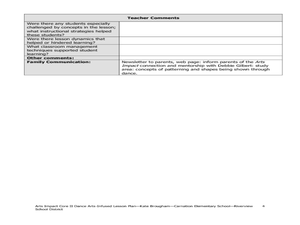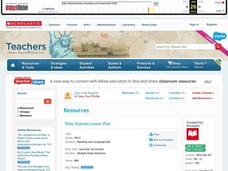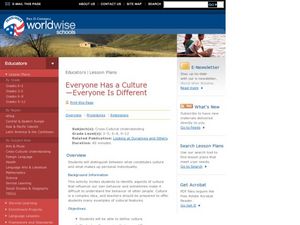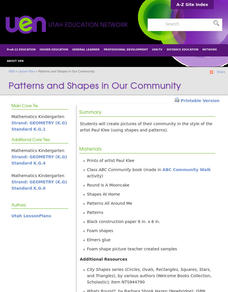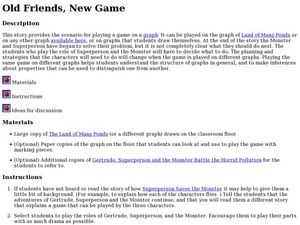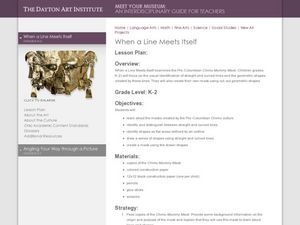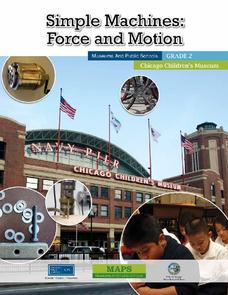Curated OER
Dancing Polygons and Non-Polygons with Patterns
Second graders study movements. In this dance lesson, 2nd graders draw patterns selecting one to represent through movement with their body.
Curated OER
Tempera Paint Lesson Ideas
Students create an abstract, non-objective paintings. Students use the various lesson plans to create abstract paintings that include an art with text lesson, a sand textured paint lesson, and a radiating design lesson.
Curated OER
Sorting
A lesson on classification and sorting is here for you. Elementary schoolers participate in an interactive computer game in which they sort books by theme. They take a trip to the library to observe and discuss how books are sorted, and...
Curated OER
Art to Zoo: Celebration
Students research and develop a report on birthday rituals around the world. In this research lesson plan, students compare birthday rituals from other cultures to their own. Images and resources are included.
Curated OER
Using Art to Draw Us Together
Students build their own bridges or make connections to other peers, teens, adults/parents, senior citizens and people from around the world through various art mediums. Through this type of instructional activity students attempt to...
Curated OER
A Turkey for Thanksgiving - Lesson #2
Second graders investigate realistic fiction, holiday celebrations, making tally charts. In this multi-disciplinary lesson, 2nd graders listen to a story about Thanksgiving and one about the Chinese New Year to develop an understanding...
Curated OER
Beautiful Bovine
Looking for a fun and interactive way to explore bovine biology? Learners read a brief informational text (included for printing) before participating in several cross-curricular activities. First, grab their attention with a hilarious...
Curated OER
Polar Express Lesson Plan
Students write and illustrate a wish for the first gift of Christmas. In this Christmas lesson plan, students read the book The Polar Express and then write what they wish could be the first gift of Christmas.
Curated OER
Everyone has a Culture-Everyone is Different
Students explore cultural features. In this multicultural acceptance lesson, students define and discuss "culture," and distinguish the difference between individual characteristics and cultural characteristics. Students...
California Academy of Science
Fraction Penguin
Exploring mathematics through art is a fun and concrete way to help learners grasp a concept. They will construct a paper penguin using fractions cut from circles. They'll need to determine 1/8, 1/4, and 1/2 of each circle. Once the...
Curated OER
How Does Your Garden Grow?
Students construct and maintain a school garden. In this gardening instructional activity, students plan the construction of the garden by writing letters to local businesses asking for supplies and materials; students build the garden...
Curated OER
Visit to Ackland Art Museum (African Masks Exhibit)
Second graders observe and describe the similarities and differences in the African Mask exhibit at the Ackland Art Museum. They use describing words to express the feelings of the masks.
Utah Education Network (UEN)
Patterns and Shapes In Our Community
Shapes in art, shapes in stories, shapes in the environment, shapes all around. A multi-part lesson that includes looking at the artist Paul Klee's work, reading books about shapes, taking a walk in the neighborhood and identifying...
Curated OER
Community and Me
First and second graders view art work, have group and class discussions, listen to stories, write themes, make notes, conduct interviews, graph results, chart findings, and plan a career day. These ambitious lessons should lead your...
Curated OER
Once Upon a Time
Young artists view pieces of artwork by Robert Harris, then have class discussions, write collaborative stories, make a painting or drawing, and analyze and create their own advertisements. This series of lessons should lead to some...
Curated OER
Lesson 12: Ho'olaulima: Let's Make a Hawaiian Garden
Second graders grow a classroom garden that acts as a living laboratory for cross-curricular activities. In this classroom garden lesson, 2nd graders follow directions to build and plant a garden that is used to teach math, science, and...
Curated OER
Making Felt Bags
Pupils study the history of bags, pouches and purses. Use of these items spans the entire globe and encompasses practically every civilization. The lesson plan culminates with learners creating their own bag from a variety of choices....
Curated OER
Planets Beyond
Students recognize basic geometric shapes. They research the positions of planets in our solar system and find information on early theories about the location of planets and the sun. Students visualize planets as they might appear in an...
Curated OER
Shape Lessons That Connect
Shape lessons provide a way for students to learn about art, science, and math.
Curated OER
Old friends, New game
Students create characters from a book. In this Language arts lesson, the students act out the story by role playing. The students learn how to articulate correctly, by working together to arrive at the same destination.
Curated OER
Mirror, Mirror on the Wall, Who Needs Math in Life at All?
Young scholars think and talk about the ways in which they use math throughout the day. They add each way to a "math in real life" bulletin board and reflect in writing on the ways they use math.
Curated OER
When A Line Meets Itself
Students investigate the linear characteristics of cultural art. In this art analysis instructional activity, students discover the Pre-Columbian Chimu culture and the many masks they created. Students identify the different...
Curated OER
Language Arts, Social Studies, African Americans, The Blues, To Kill A Mockingbird
African American history during the Jim Crow era includes encounters with poverty, racism, disrespect, and protest. Harper Lee develops all four of these themes in her famous 1960 novel, To Kill a Mockingbird. To help students understand...
Chicago Children's Museum
Simple Machines: Force and Motion
Get things moving with this elementary science unit on simple machines. Through a series of nine lessons including teacher demonstrations, hands-on activities, and science experiments, young scientists learn about forces, motion,...
